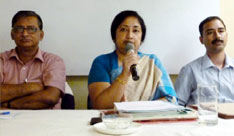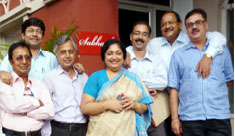Effects of stroke
Paralysis in the arms, hands, face, chest, legs or feet
can cause:
• Loss of balance
• Difficulty walking
• Impaired ability to grasp objects
• Decrease in movement precision
• Muscle fatigue
• Lack of coordination
Spasticity:
Spasticity is a form of paralysis that affects roughly 40 percent of stroke survivors and is characterized by stiff or tight muscles. The tight muscles constrict movement, making it difficult to lift things, walk or perform daily activities of living.
Dysphagia:
Stroke is the leading cause of dysphagia, which is the paralysis of the throat muscles. This can disrupt the swallowing process and make eating, drinking, taking medicine and breathing difficult. More than 70 percent of stroke survivors experience dysphagia at some point after a stroke. Identifying swallowing issues early reduces hospital stays, healthcare costs and complications that include but are not limited to dehydration, malnutrition, aspiration and pneumonia.
Incontinence:
Incontinence refers to a lack of ability to control bladder and or bowel movements. Incontinence affects 40 to 60 percent of patients admitted to a hospital after having a stroke.
The severity of post-stroke incontinence depends on the following factors.
Severity of the stroke
Age
Diabetes
Sensory loss
Over-responsiveness (hyperreflexia) or under-responsiveness (hyporeflexia)
Pain:
Each person feels pain differently. Damage to the brain due to stroke can sometimes make the sense of touch hurt. Pain can result from things like muscle tightness or weakness. Pain can slow recovery from disease or injury and weaken the immune system. Also, it can lead to a lower quality of life, interfering with routine activities that make life rich and fulfilling, such as driving, shopping or hugging a child or grandchild. Most post-stroke pain can be treated. Proper treatment requires a doctor’s involvement and possibly an integrative treatment approach, which could mean combining prescription medicines with complementary medicine, such as physical therapy or massage. Pain can occur right after a stroke or weeks or even months after a stroke. Research indicates that as many as 74 percent of stroke survivors face some form of pain. In some cases, pain is constant (chronic). In others, it comes and goes.
Sleep problems:
A stroke survivor may experience changes related to sleep. One of the biggest sleep-related issues that can develop after a stroke is sleep-related breathing disorders. Other common ways stroke affects sleep is changing sleep patterns, as in sleeping more during the day than at night, and insomnia.
Seizures:
A seizure is a sudden episode of abnormal or disorganized electric activity in the brain. Stroke is the most common cause of seizures in the aging population and approximately 10 percent of stroke survivors experience a seizure after a stroke. Seizures can be characterized by spasms or convulsions.
Epilepsy is a neurological disorder in which recurrent seizures occur that cannot be associated with other specific causes. Seizures, as well as the onset of epilepsy, can occur after a stroke. Having one seizure after a stroke does not necessarily mean a person has epilepsy; however, if chronic and recurring seizures are a result of a stroke, then a stroke survivor may be diagnosed with epilepsy.
When stroke warning signs are not clearly present, a seizure may indicate that a person had a stroke, especially in children and infants.
Symptoms (Incidence)
It is difficult to predict which stroke survivors will have a seizure since research on post-stroke seizures varies widely. Two to 33 percent of stroke survivors who had an ischemic stroke will experience a seizure. Additionally, seizures are more serious if they occur shortly after a stroke and stroke survivors who have a hemorrhagic stroke are more likely to have seizures within the first 24 hours. Studies show that people who have a seizure within 24 hours of a stroke have a higher mortality rate, making it essential that everyone knows the signs and symptoms of a seizure.
If someone has a seizure:
Roll the person on his or her side to prevent choking or vomiting.
Cushion the person’s head.
Loosen any tight clothing around the neck.
Keep the person’s airway open. If necessary, grip the person’s jaw gently and tilt his or her head back.
Do not restrict the person from moving unless he or she is in danger.
Do not put anything in the person’s mouth, not even medicine or liquid.
Remove any sharp or solid objects that the person might hit during the seizure.
Note how long the seizure lasts and what symptoms occurred in order to inform a doctor or emergency personnel if necessary.
Stay with the person until the seizure ends.
Cognitive effects of stroke:
APHASIA:
Aphasia is a disorder of communication that impairs a person’s ability to use and comprehend language. Aphasia is a symptom of brain damage and affects approximately one million Americans. Stroke is the leading cause of aphasia. One in four stroke survivors experience some form of language impairment after a stroke. Speech is primarily controlled by the Broca’s and Wernicke’s regions of the brain.
Strokes that damage the frontal and parietal lobes in the right hemisphere of the brain can cause a person to have difficulty expressing and processing language.
Aphasia may make it difficult to:
Speak
Understand spoken language
Read
Write
Use numbers and do calculations
Use non-verbal gesturing
Depression:
A stroke survivor’s emotional health is just as important as his or her physical health and can promote or disrupt post-stroke recovery. Many stroke survivors experience feelings of anger, frustration, anxiety, sadness, fear and hopelessness in varying degrees. These emotions are common with post-stroke depression, which affects more than a third of stroke survivors. The National Institute of Neurological Disorders and Stroke characterizes post-stroke depression by a feeling of hopelessness that interferes with functioning and inhibits quality of life. If not treated and managed appropriately, post-stroke depression can slow down recovery.
Depression can set in weeks, months or even years after a stroke and can inhibit progress of recovery and rehabilitation, impacting a stroke survivor’s quality of life. A combination of factors can lead to post-stroke depression. The sudden nature of stroke can have a life-changing impact for many stroke survivors and their families. Damage to brain tissue after a stroke, genetics and social factors can also contribute to depression.
Symptoms:
Symptoms of memory loss after a stroke may include:
Confusion
Problems with short-term memory
Wandering
Getting lost in familiar places
Difficulty following instructions
Trouble making monetary transactions
Memory problems can be subtle and their cause difficult to diagnose. Symptoms of memory loss are very similar to symptoms of vascular dementia and Alzheimer’s disease and memory loss may exist together with one of these conditions.
Memory loss may be a direct result of stroke, but can also be caused or worsened by:
Medications
Alcohol, tobacco and drugs
Sleep deprivation
Depression and stress
Nutritional deficiency
Pseudo-bulbar affect:
Explaining Unpredictable Emotional Episodes
Pseudobulbar affect (PBA) is a medical condition characterized by sudden and uncontrollable episodes of crying or laughing. It is sometimes referred to as emotional liability, pathological crying and laughing or emotional incontinence. An episode of PBA can occur at any time, even in inappropriate social situations.














